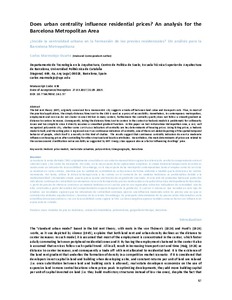Mostra el registre d'ítem simple
Does urban centrality influence residential prices? An analysis for the Barcelona Metropolitan Area
| dc.contributor.author | Marmolejo Duarte, Carlos Ramiro |
| dc.contributor.other | Universitat Politècnica de Catalunya. Departament de Tecnologia de l'Arquitectura |
| dc.date.accessioned | 2017-09-14T17:26:39Z |
| dc.date.available | 2017-09-14T17:26:39Z |
| dc.date.issued | 2017-04-01 |
| dc.identifier.citation | Marmolejo, C. Does urban centrality influence residential prices? An analysis for the Barcelona Metropolitan Area. "Revista de la Construccion", 1 Abril 2017, vol. 16, núm. 1, p. 57-65. |
| dc.identifier.issn | 0718-915X |
| dc.identifier.uri | http://hdl.handle.net/2117/107643 |
| dc.description.abstract | The bid rent theory (BRT), originally conceived for a monocentric city suggests a trade-off between land value and transport costs. Thus, in most of the practical applications, the simply distance/time/cost to the CBD is used as a proxy of accessibility. Nonetheless, in contemporary metropolises, employment and services do not cluster in one CBD but in many centers, furthermore the centrality quality does not follow a smooth gradient as distance to centers increases. Consequently, taking the distance/time/cost to centers in the context or hedonic models is problematic for collinearity issues and too simplistic since it directly assumes a smoothed gradient function. In this paper we test in Barcelona Metropolitan Area, a very well recognized polycentric city, whether some continuous indicators of centrality are key determinants of housing prices. Using listing prices, a hedonic model is built, and the asking price is regressed over two continuous indicators of centrality, one of them calculated departing of the spatial-temporal behavior of people, which itself is a novelty in this kind of studies. The results suggest that continuous centrality indicators do exert a moderate influence on housing prices after controlling for other structural and locative attributes. Nevertheless, the main determinants of prices are related to the socioeconomic stratification not accessibility as suggested by BRT. Energy class appears also as a factor influencing dwellings' price. |
| dc.format.extent | 9 p. |
| dc.language.iso | eng |
| dc.rights | Attribution-NonCommercial-NoDerivs 3.0 Spain |
| dc.rights.uri | http://creativecommons.org/licenses/by-nc-nd/3.0/es/ |
| dc.subject | Àrees temàtiques de la UPC::Urbanisme::Aspectes econòmics |
| dc.subject | Àrees temàtiques de la UPC::Urbanisme::Aspectes socials |
| dc.subject.lcsh | Real property -- Valuation -- Barcelona Metropolitan Area (Spain) |
| dc.subject.lcsh | City plannig -- Barcelona Metropolitan Area (Spain) |
| dc.subject.other | Hedonic price models |
| dc.subject.other | Real estate valuation |
| dc.subject.other | Polycentrism |
| dc.subject.other | Time-geography |
| dc.subject.other | Barcelona |
| dc.subject.other | Modelos de precios hedónicos |
| dc.subject.other | Valoración inmobiliaria |
| dc.subject.other | Policentrismo |
| dc.subject.other | Geografía del tiempo |
| dc.title | Does urban centrality influence residential prices? An analysis for the Barcelona Metropolitan Area |
| dc.type | Article |
| dc.subject.lemac | Béns immobles -- Valoració -- Catalunya -- Àrea Metropolitana de Barcelona |
| dc.subject.lemac | Àrees de nova centralitat -- Catalunya -- Àrea Metropolitana de Barcelona |
| dc.subject.lemac | Urbanisme -- Catalunya -- Àrea Metropolitana de Barcelona |
| dc.contributor.group | Universitat Politècnica de Catalunya. CPSV - Centre de Política de Sòl i Valoracions |
| dc.identifier.doi | 10.7764/RDLC.16.1.57 |
| dc.relation.publisherversion | http://rdlc.alerta.cl/index.php/rdlc/article/view/638 |
| dc.rights.access | Open Access |
| local.identifier.drac | 21493310 |
| dc.description.version | Postprint (published version) |
| local.citation.author | Marmolejo, C. |
| local.citation.publicationName | Revista de la Construccion |
| local.citation.volume | 16 |
| local.citation.number | 1 |
| local.citation.startingPage | 57 |
| local.citation.endingPage | 65 |
Fitxers d'aquest items
Aquest ítem apareix a les col·leccions següents
-
Articles de revista [558]
-
Articles de revista [129]


